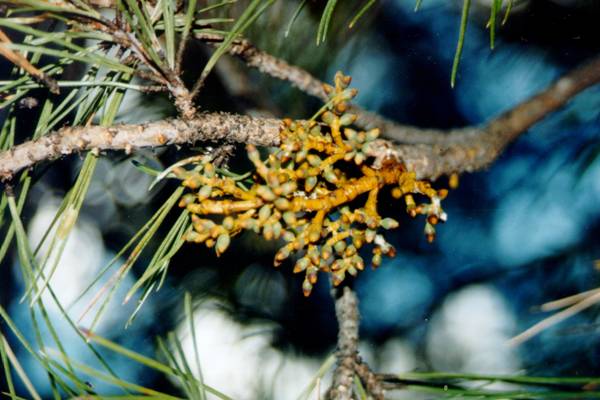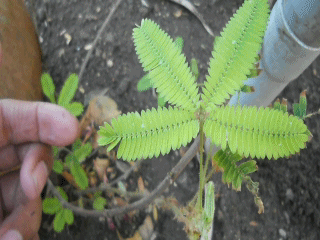|
Arceuthobium
The genus ''Arceuthobium'', commonly called dwarf mistletoes, is a genus of 26 species of parasitic plants that parasitize members of Pinaceae and Cupressaceae in North America, Central America, Asia, Europe, and Africa. Of the 42 species that have been recognized, 39 and 21 of these are endemic to North America and the United States, respectively. They all have very reduced shoots and leaves (mostly reduced to scales) with the bulk of the plant living under the host's bark. Recently the number of species within the genus has been reduced to 26 as a result of more detailed genetic analysis. Description They are dioecious, individual plants being either male or female. The fruit is unusual in that it builds up hydrostatic pressure internally when ripe and shoots the single sticky seed up to speeds nearly , an example of rapid plant movement. The lodgepole pine dwarf mistletoe,'' Arceuthobium americanum, has been found to explosively-disperse its seeds through thermogenesis. [...More Info...] [...Related Items...] OR: [Wikipedia] [Google] [Baidu] |
List Of Arceuthobium Species
Recently the number of species within the ''Arceuthobium'' has been reduced from 42 to 26. The structure of the subgenera and sections follows Nickrent ''et al.'' (2004) who resolved the phylogeny of the genus using nuclear ribosomal internal transcribed spacer (ITS) sequences and chloroplast trnT-L-F sequences. Much of the work in ''Arceuthobium'' systematics was undertaken and compiled by Hawksworth and Wiens Subgenus Arceuthobium Section ''Arceuthobium'' * '' Arceuthobium juniperi-procerae'' Chiovenda (Parasite of ''Juniperus'') * ''Arceuthobium oxycedri'' (DC) Bieb. (Parasite of ''Juniperus'') * '' Arceuthobium tibetense'' H.S. Kiu & W. Ren (Parasite of ''Abies forrestii'') Section Chinense Nickrent * '' Arceuthobium chinense'' Lecomte * '' Arceuthobium minutissimum'' J.D: Hooker * '' Arceuthobium sicuanense'' (H.S. Kiu) D. Hawksw. & Wiens * ''Arceuthobium pini'' D. Hawksw. & Wiens Section Azorica * ''Arceuthobium azoricum'' (Parasite of ''Juniperus brevifolia'') Subge ... [...More Info...] [...Related Items...] OR: [Wikipedia] [Google] [Baidu] |
Arceuthobium Vaginatum Subsp
The genus ''Arceuthobium'', commonly called dwarf mistletoes, is a genus of 26 species of parasitic plants that parasitize members of Pinaceae and Cupressaceae in North America, Central America, Asia, Europe, and Africa. Of the 42 species that have been recognized, 39 and 21 of these are endemic to North America and the United States, respectively. They all have very reduced shoots and leaves (mostly reduced to scales) with the bulk of the plant living under the host's bark. Recently the number of species within the genus has been reduced to 26 as a result of more detailed genetic analysis. Description They are dioecious, individual plants being either male or female. The fruit is unusual in that it builds up hydrostatic pressure internally when ripe and shoots the single sticky seed up to speeds nearly , an example of rapid plant movement. The lodgepole pine dwarf mistletoe,'' Arceuthobium americanum, has been found to explosively-disperse its seeds through thermogenesis. [...More Info...] [...Related Items...] OR: [Wikipedia] [Google] [Baidu] |
Arceuthobium Americanum
''Arceuthobium americanum'' is a species of dwarf mistletoe known as American dwarf mistletoe and lodgepole-pine dwarf mistletoe. It is a common plant of western North America where it lives in high elevation pine forests. It is a parasitic plant which lives upon the Lodgepole Pine, particularly the subspecies ''Pinus contortus'' ssp. ''murrayana'', the Tamarack Pine. This pine subspecies is most common in the Cascade Range and Sierra Nevada. The American dwarf mistletoe is a yellow-green coral-shaped structure above the surface of the tree's bark, while most of the parasite is beneath the bark. The seeds mature in late summer and disperse to nearby trees. This species has been found to explosively-disperse its seeds through thermogenesis. Rolena A.J. deBruyn, Mark Paetkau, Kelly A. Ross, David ... [...More Info...] [...Related Items...] OR: [Wikipedia] [Google] [Baidu] |
Mistletoe
Mistletoe is the common name for obligate hemiparasitic plants in the order Santalales. They are attached to their host tree or shrub by a structure called the haustorium, through which they extract water and nutrients from the host plant. The name mistletoe originally referred to the species ''Viscum album'' (European mistletoe, of the family Santalaceae in the order Santalales); it is the only species native to the British Isles and much of Europe. A related species with red rather than white fruits, ''Viscum cruciatum'', occurs in Southwest Spain and Southern Portugal, as well as in Morocco in North Africa and in southern Africa. The genus ''Viscum'' is not native to North America, but ''Viscum album'' was introduced to Northern California in 1900. The eastern mistletoe native to North America, ''Phoradendron leucarpum'', belongs to a distinct genus of the family Santalaceae. European mistletoe has smooth-edged, oval, evergreen leaves borne in pairs along the woody st ... [...More Info...] [...Related Items...] OR: [Wikipedia] [Google] [Baidu] |
Cynthia Ross Friedman
Cynthia "Cindy" Ross Friedman (1970 or 1971 – 24 December 2018) was a professor in biological sciences at Thompson Rivers University in Kamloops, British Columbia, Canada. She was inducted into the inaugural cohort of the Royal Society of Canada's College of New Scholars, Artists, and Scientists in 2014 and as a fellow of the Royal Society of Arts in 2016. Research In a ''Nature Communications'' paper, her research group showed that the parasitic flowering plant ''Arceuthobium americanum'' (Lodegpole pine dwarf mistletoe) undergoes thermogenesis (internal heat generation) to explosively discharge its seeds. Media appearances and activism She was on national radio and television in many instances not only to discuss her team's research but also to act as a spokesperson for a coalition of concerned community groups opposed to the proposed KGHM Ajax mine, a copper-gold open-pit mine project proposed to be located within 1 km of the Kamloops city boundary. Music Ross Friedm ... [...More Info...] [...Related Items...] OR: [Wikipedia] [Google] [Baidu] |
Blue Pine
''Pinus wallichiana'' is a coniferous evergreen tree native to the Himalaya, Karakoram and Hindu Kush mountains, from eastern Afghanistan east across northern Pakistan and north west India to Yunnan in southwest China. It grows in mountain valleys at altitudes of 1800–4300 m (rarely as low as 1200 m), reaching in height. It favours a temperate climate with dry winters and wet summers. In Pashto, it is known as ''Nishtar''. This tree is often known as Bhutan pine, (not to be confused with the recently described Bhutan white pine, '' Pinus bhutanica'', a closely related species). Other names include blue pine, Himalayan pine and Himalayan white pine. Description The leaves ("needles") are in fascicles (bundles) of five and are 12–18 cm long. They are noted for being flexible along their length, and often droop gracefully. The cones are long and slender, 16–32 cm, yellow-buff when mature, with thin scales; the seeds are 5–6 mm long with a 20–30 ... [...More Info...] [...Related Items...] OR: [Wikipedia] [Google] [Baidu] |
Rapid Plant Movement
Rapid plant movement encompasses plant movements, movement in plant structures occurring over a very short period, usually under one second. For example, the Venus flytrap closes its trap in about 100 milliseconds. The traps of Utricularia are much faster, closing in about 0.5 milliseconds. The dogwood bunchberry's flower opens its petals and fires pollen in less than 0.5 milliseconds. The record is currently held by the white mulberry tree, with flower movement taking 25 microseconds, as pollen is catapulted from the stamens at velocities in excess of half the speed of sound—near the theoretical physical limits for movements in plants.Taylor, P.E., G. Card, J. House, M. H. Dickinson & R.C. Flagan 2006. High-speed pollen release in the white mulberry tree, ''Morus alba'' L.. ''Sexual Plant Reproduction'' 19(1): 19–24. These rapid plant movements differ from the more common, but much slower "growth-movements" of plants, called tropisms. Tropisms encompass movements that lead to ... [...More Info...] [...Related Items...] OR: [Wikipedia] [Google] [Baidu] |
Parasitic Plant
A parasitic plant is a plant that derives some or all of its nutritional requirements from another living plant. They make up about 1% of angiosperms and are found in almost every biome. All parasitic plants develop a specialized organ called the haustorium, which penetrates the host plant, connecting them to the host vasculature – either the xylem, phloem, or both. For example, plants like ''Striga'' or ''Rhinanthus'' connect only to the xylem, via xylem bridges (xylem-feeding). Alternately, plants like ''Cuscuta'' and some members of ''Orobanche'' connect to both the xylem and phloem of the host. This provides them with the ability to extract water and nutrients from the host. Parasitic plants are classified depending on the location where the parasitic plant latches onto the host (root or stem), the amount of nutrients it requires, and their photosynthetic capability. Some parasitic plants can locate their host plants by detecting volatile chemicals in the air or soil given ... [...More Info...] [...Related Items...] OR: [Wikipedia] [Google] [Baidu] |
Thermogenesis
Thermogenesis is the process of heat production in organisms. It occurs in all warm-blooded animals, and also in a few species of thermogenic plants such as the Eastern skunk cabbage, the Voodoo lily (''Sauromatum venosum''), and the giant water lilies of the genus ''Victoria''. The lodgepole pine dwarf mistletoe, ''Arceuthobium americanum'', disperses its seeds explosively through thermogenesis.Rolena A.J. deBruyn, Mark Paetkau, Kelly A. Ross, David V. Godfrey & Cynthia Ross Friedman (2015)"Thermogenesis-triggered seed dispersal in dwarf mistletoe" Types Depending on whether or not they are initiated through locomotion and intentional movement of the muscles, thermogenic processes can be classified as one of the following: * Exercise-associated thermogenesis (EAT) * Non-exercise activity thermogenesis (NEAT), energy expended for everything that is not sleeping, eating or sports-like exercise. * Diet-induced thermogenesis (DIT) Shivering One method to raise temperature is thr ... [...More Info...] [...Related Items...] OR: [Wikipedia] [Google] [Baidu] |
Hygroscopy
Hygroscopy is the phenomenon of attracting and holding water molecules via either absorption or adsorption from the surrounding environment, which is usually at normal or room temperature. If water molecules become suspended among the substance's molecules, adsorbing substances can become physically changed, e.g., changing in volume, boiling point, viscosity or some other physical characteristic or property of the substance. For example, a finely dispersed hygroscopic powder, such as a salt, may become clumpy over time due to collection of moisture from the surrounding environment. ''Deliquescent'' materials are sufficiently hygroscopic that they absorb so much water that they become liquid and form an aqueous solution. Etymology and pronunciation The word ''hygroscopy'' () uses combining forms of '' hygro-'' and '' -scopy''. Unlike any other ''-scopy'' word, it no longer refers to a viewing or imaging mode. It did begin that way, with the word ''hygroscope'' referring in the ... [...More Info...] [...Related Items...] OR: [Wikipedia] [Google] [Baidu] |
Viscin
{{Short pages monitor ... [...More Info...] [...Related Items...] OR: [Wikipedia] [Google] [Baidu] |
Friedrich August Marschall Von Bieberstein
Baron Friedrich August Marschall von Bieberstein (30 July 1768 in Stuttgart – 28 June 1826 in Merefa) was an early explorer of the flora and archeology of the southern portion of Imperial Russia, including the Caucasus and Novorossiya. He compiled the first comprehensive flora catalogue of the Crimeo-Caucasian region. Origin Friedrich Marschall von Bieberstein was the son of a Colonel from Württemberg 'Conrad Otto Christoph Freiherr Marschall von Bieberstein' (17 March 1726 – 25 May 1796), and his wife 'Johanna Theresia Henriette' née Wolf from Ludwigsburg (21 December 1738 – 1783). They married on 21 September 1761. The 'Marschall von Bieberstein' family can trace its origins back over 800 years to the region today called Saxony in eastern Germany. The current family name derives from Bieberstein castle near Dresden. He had three brothers, Carl Wilhelm Marschall von Bieberstein (1764–1817), who was from 1792 worked in Baden, then in 1800 became President of the Privy C ... [...More Info...] [...Related Items...] OR: [Wikipedia] [Google] [Baidu] |




